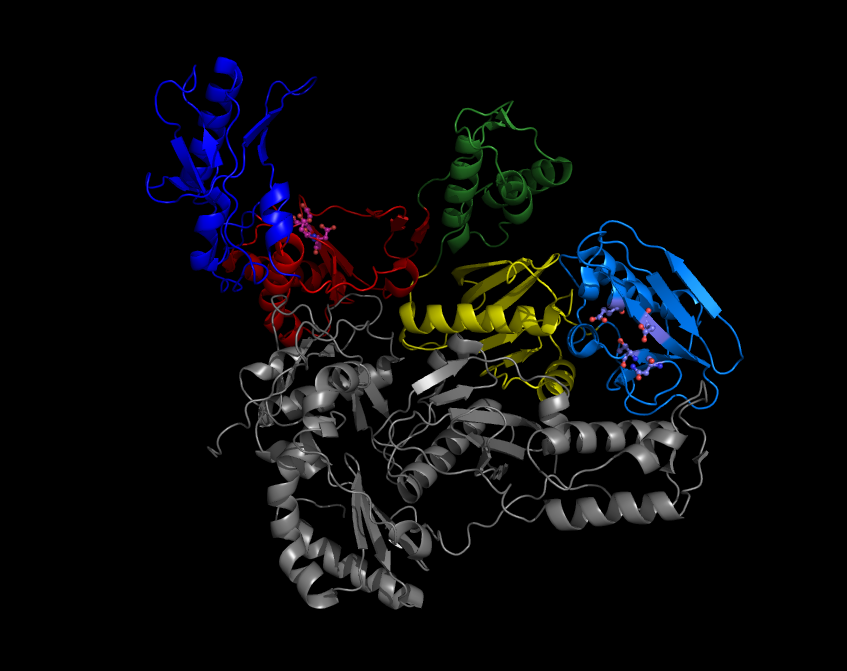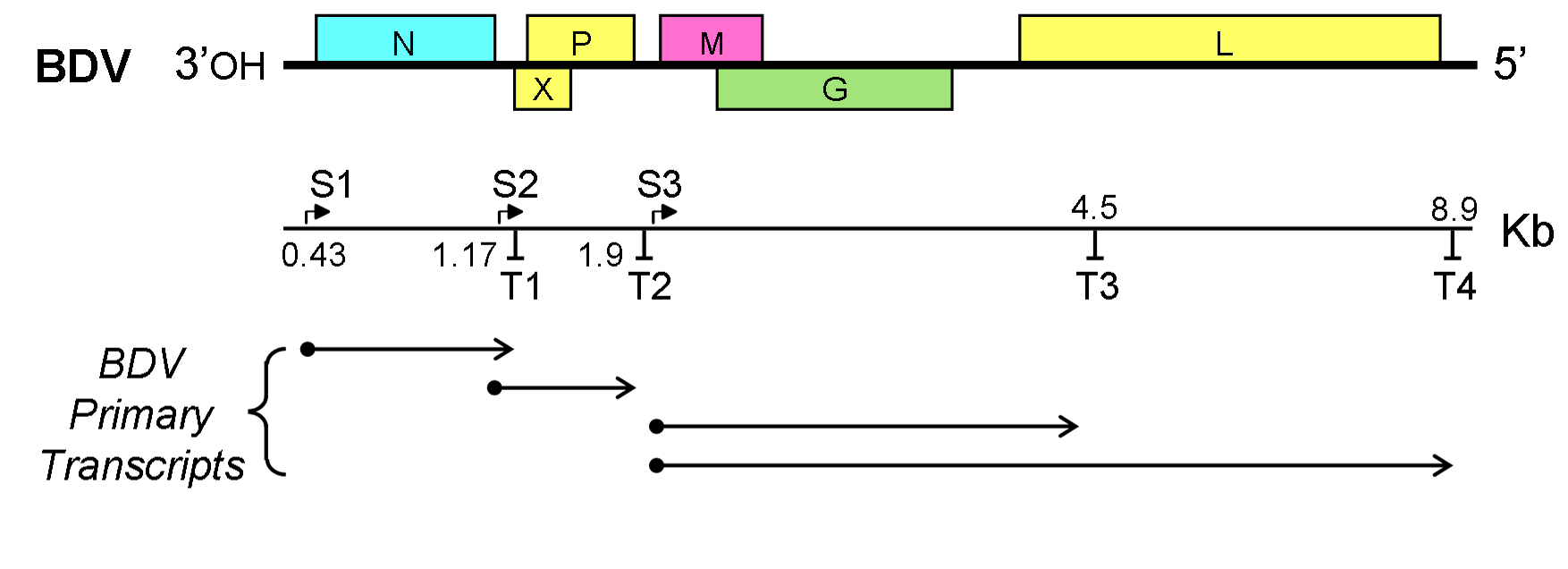|
Provirus
A provirus is a virus genome that is integrated into the DNA of a host cell. In the case of bacterial viruses (bacteriophages), proviruses are often referred to as prophages. However, proviruses are distinctly different from prophages and these terms should not be used interchangeably. Unlike prophages, proviruses do not excise themselves from the host genome when the host cell is stressed. This state can be a stage of virus replication, or a state that persists over longer periods of time as either inactive viral infections or an endogenous viral element. In inactive viral infections the virus will not replicate itself except through replication of its host cell. This state can last over many host cell generations. Endogenous retroviruses are always in the state of a provirus. When a (nonendogenous) retrovirus invades a cell, the RNA of the retrovirus is reverse-transcribed into DNA by reverse transcriptase, then inserted into the host genome by an integrase. A provirus does n ... [...More Info...] [...Related Items...] OR: [Wikipedia] [Google] [Baidu] |
Virus
A virus is a submicroscopic infectious agent that replicates only inside the living Cell (biology), cells of an organism. Viruses infect all life forms, from animals and plants to microorganisms, including bacteria and archaea. Viruses are found in almost every ecosystem on Earth and are the most numerous type of biological entity. Since Dmitri Ivanovsky's 1892 article describing a non-bacterial pathogen infecting tobacco plants and the discovery of the tobacco mosaic virus by Martinus Beijerinck in 1898, more than 16,000 of the millions of List of virus species, virus species have been described in detail. The study of viruses is known as virology, a subspeciality of microbiology. When infected, a host cell is often forced to rapidly produce thousands of copies of the original virus. When not inside an infected cell or in the process of infecting a cell, viruses exist in the form of independent viral particles, or ''virions'', consisting of (i) genetic material, i.e., long ... [...More Info...] [...Related Items...] OR: [Wikipedia] [Google] [Baidu] |
Endogenous Retrovirus
Endogenous retroviruses (ERVs) are endogenous viral elements in the genome that closely resemble and can be derived from retroviruses. They are abundant in the genomes of jawed vertebrates, and they comprise up to 5–8% of the human genome (lower estimates of ~1%). An ERV is a vertically inherited proviral sequence and a subclass of a type of gene called a transposon, which can normally be packaged and moved within the genome to serve a vital role in gene expression and in regulation. ERVs, however, lack most transposon functions, are typically not infectious, and are often defective genomic remnants of the retroviral replication cycle. They are distinguished as germline provirus retroelements due to their integration and reverse-transcription into the nuclear genome of the host cell. Researchers have suggested that retroviruses evolved from a type of transposon called a retrotransposon, a Class I element; these genes can mutate and instead of moving to another locati ... [...More Info...] [...Related Items...] OR: [Wikipedia] [Google] [Baidu] |
Integrase
Retroviral integrase (IN) is an enzyme An enzyme () is a protein that acts as a biological catalyst by accelerating chemical reactions. The molecules upon which enzymes may act are called substrate (chemistry), substrates, and the enzyme converts the substrates into different mol ... produced by a retrovirus (such as HIV) that integrates (forms covalent links between) its genetic information into that of the host cell it infects. Retroviral INs are not to be confused with phage integrases ( recombinases) used in biotechnology, such as λ phage integrase, as discussed in site-specific recombination. The macromolecular complex of an IN macromolecule bound to the ends of the viral DNA ends has been referred to as the '' intasome''; IN is a key component in this and the retroviral pre-integration complex. Structure All retroviral IN proteins contain three canonical domains, connected by flexible linkers: * an N-terminal HH-CC zinc-binding domain (a three-heli ... [...More Info...] [...Related Items...] OR: [Wikipedia] [Google] [Baidu] |
Endogenous Retrovirus
Endogenous retroviruses (ERVs) are endogenous viral elements in the genome that closely resemble and can be derived from retroviruses. They are abundant in the genomes of jawed vertebrates, and they comprise up to 5–8% of the human genome (lower estimates of ~1%). An ERV is a vertically inherited proviral sequence and a subclass of a type of gene called a transposon, which can normally be packaged and moved within the genome to serve a vital role in gene expression and in regulation. ERVs, however, lack most transposon functions, are typically not infectious, and are often defective genomic remnants of the retroviral replication cycle. They are distinguished as germline provirus retroelements due to their integration and reverse-transcription into the nuclear genome of the host cell. Researchers have suggested that retroviruses evolved from a type of transposon called a retrotransposon, a Class I element; these genes can mutate and instead of moving to another locati ... [...More Info...] [...Related Items...] OR: [Wikipedia] [Google] [Baidu] |
Endogenous Viral Element
An endogenous viral element (EVE) is a DNA sequence derived from a virus, and present within the germline of a non-viral organism. EVEs may be entire viral genomes ( proviruses), or fragments of viral genomes. They arise when a viral DNA sequence becomes integrated into the genome of a germ cell that goes on to produce a viable organism. The newly established EVE can be inherited from one generation to the next as an allele in the host species, and may even reach fixation. Endogenous retroviruses and other EVEs that occur as proviruses can potentially remain capable of producing infectious virus in their endogenous state. Replication of such 'active' endogenous viruses can lead to the proliferation of viral insertions in the germline. For most non-retroviral viruses, germline integration appears to be a rare, anomalous event, and the resulting EVEs are often only fragments of the parent virus genome. Such fragments are usually not capable of producing infectious virus, but may ... [...More Info...] [...Related Items...] OR: [Wikipedia] [Google] [Baidu] |
Reverse Transcriptase
A reverse transcriptase (RT) is an enzyme used to convert RNA genome to DNA, a process termed reverse transcription. Reverse transcriptases are used by viruses such as HIV and hepatitis B to replicate their genomes, by retrotransposon mobile genetic elements to proliferate within the host genome, and by eukaryotic cells to extend the telomeres at the ends of their linear chromosomes. The process does not violate the flows of genetic information as described by the classical central dogma, but rather expands it to include transfers of information from RNA to DNA. Retroviral RT has three sequential biochemical activities: RNA-dependent DNA polymerase activity, ribonuclease H (RNase H), and DNA-dependent DNA polymerase activity. Collectively, these activities enable the enzyme to convert single-stranded RNA into double-stranded cDNA. In retroviruses and retrotransposons, this cDNA can then integrate into the host genome, from which new RNA copies can be made via host-cell ... [...More Info...] [...Related Items...] OR: [Wikipedia] [Google] [Baidu] |
Bacteriophage
A bacteriophage (), also known informally as a phage (), is a virus that infects and replicates within bacteria. The term is derived . Bacteriophages are composed of proteins that Capsid, encapsulate a DNA or RNA genome, and may have structures that are either simple or elaborate. Their genomes may encode as few as four genes (e.g. Bacteriophage MS2, MS2) and as many as hundreds of genes. Phages replicate within the bacterium following the injection of their genome into its cytoplasm. Bacteriophages are among the most common and diverse entities in the biosphere. Bacteriophages are ubiquitous viruses, found wherever bacteria exist. It is estimated there are more than 1031 bacteriophages on the planet, more than every other organism on Earth, including bacteria, combined. Viruses are the most abundant biological entity in the water column of the world's oceans, and the second largest component of biomass after prokaryotes, where up to 9x108 virus, virions per millilitre have b ... [...More Info...] [...Related Items...] OR: [Wikipedia] [Google] [Baidu] |
Temperateness (virology)
In virology, temperate refers to the ability of some bacteriophages (notably coliphage λ) to display a lysogenic life cycle. Many (but not all) temperate phages can integrate their genomes into their host bacterium's chromosome, together becoming a lysogen as the phage genome becomes a prophage. A temperate phage is also able to undergo a productive, typically lytic life cycle, where the prophage is expressed, replicates the phage genome, and produces phage progeny, which then leave the bacterium. With phage the term virulent is often used as an antonym to temperate, but more strictly a virulent phage is one that has lost its ability to display lysogeny through mutation rather than a phage lineage with no genetic potential to ever display lysogeny (which more properly would be described as an obligately lytic phage). Induction of the lytic cycle At some point, temperate bacteriophages switch from the lysogenic life cycle to the lytic life cycle. This conversion may happen s ... [...More Info...] [...Related Items...] OR: [Wikipedia] [Google] [Baidu] |
Bornavirus
''Bornaviridae'' is a family of negative-strand RNA viruses in the order ''Mononegavirales''. Horses, sheep, cattle, rodents, birds, reptiles, and humans serve as natural hosts. Diseases associated with bornaviruses include Borna disease, a fatal neurologic disease of mammals restricted to central Europe; and Proventricular dilatation disease, proventricular dilatation disease (PDD) in birds. Bornaviruses may cause encephalitis in mammals like horses or sheep. The family contains four genera. History Borna disease was first identified in 1926 and its genome was isolated in 1990. The ICTV proposed the creation in 1996 of the family ''Bornaviridae'' along with the genus ''Bornaviru''s (today ''Orthobornavirus''). The viral family is named after the city of Borna, Leipzig, Borna in Saxony, Saxony, Germany, which is where many animals were lost to the sporadic encephalopathy caused by the viral disease. Structure Orthobornavirions are enveloped, with spherical geometries and he ... [...More Info...] [...Related Items...] OR: [Wikipedia] [Google] [Baidu] |
Adeno-Associated Virus
Adeno-associated viruses (AAV) are small viruses that infect humans and some other primate species. They belong to the genus '' Dependoparvovirus'', which in turn belongs to the family ''Parvoviridae''. They are small (approximately 26 nm in diameter) replication-defective, nonenveloped viruses and have linear single-stranded DNA (ssDNA) genome of approximately 4.8 kilobases (kb). Several features make AAV an attractive candidate for creating viral vectors for gene therapy, and for the creation of isogenic human disease models. Gene therapy vectors using AAV can infect both dividing and quiescent cells and persist in an extrachromosomal state without integrating into the genome of the host cell. In the native virus, however, integration of virally carried genes into the host genome does occur. Integration can be important for certain applications, but can also have unwanted consequences. Recent human clinical trials using AAV for gene therapy in the retina have shown ... [...More Info...] [...Related Items...] OR: [Wikipedia] [Google] [Baidu] |
Horizontal Gene Transfer
Horizontal gene transfer (HGT) or lateral gene transfer (LGT) is the movement of genetic material between organisms other than by the ("vertical") transmission of DNA from parent to offspring (reproduction). HGT is an important factor in the evolution of many organisms. HGT is influencing scientific understanding of higher-order evolution while more significantly shifting perspectives on bacterial evolution. Horizontal gene transfer is the primary mechanism for the spread of antibiotic resistance in bacteria, and plays an important role in the evolution of bacteria that can degrade novel compounds such as human-created Bactericide, pesticides and in the evolution, maintenance, and transmission of virulence. It often involves Temperateness (virology), temperate bacteriophages and plasmids. Genes responsible for antibiotic resistance in one species of bacteria can be transferred to another species of bacteria through various mechanisms of HGT such as Transformation (genetics), tr ... [...More Info...] [...Related Items...] OR: [Wikipedia] [Google] [Baidu] |






